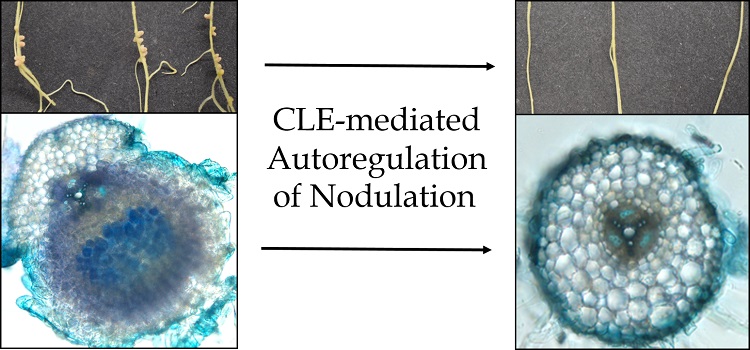PS Seminar LEAPS edition: CLE-mediated Autoregulation of Nodulation
Speakers
Event series
Content navigation
Description

Peptide hormones and their corresponding receptors play important roles in controlling lateral organ formation in plant roots via long distance signalling systems. One classic example is the control of root nodule number on legumes, called autoregulation of nodulation (AON), which has evolved to balance the carbon cost of supporting root nodules with the benefit of biological nitrogen fixation. Genetic analysis suggests that the AON in the pasture legume Medicago, primarily depends on the interaction of MtCLE12 and MtCLE13 peptides synthesised in root nodules with the leucine rich repeat receptor shoot receptor, SUNN (SUPER NUMERIC NODULES) and involves the RDN1 (ROOT-DETERMINED NODULATION 1) function in the root. RDN1, a hydroxyproline-O-arabinosyl transferase, is thought to catalyse a key step in the post-translational glyco-modification of MtCLE12, but not MtCLE13, to either protect the peptide from degradation during root-to-shoot movement or to enable SUNN perception. The in vivo functional structures of MtCLE12 and MtCLE13 peptides remain elusive.
We combined genetic and chemical synthesis as well as mass spectrometry approaches to determine (a) if arabinosyl-modifications of three nodule-expressed CLE peptides, MtCLE12, 13 and 42, are essential for AON and (b) to elucidate the in vivo structures of the AON CLE peptides. We synthetised 12 amino acid MtCLE12, MtCLE13 and MtCLE42 peptides with hydroxylation, mono-arabinosylation or tri-arabinosylation (TaP) modifications at proline 7 to determine the structural requirements for AON. Only MtCLE12-TaP and MtCLE13-TaP peptides induced AON in wild-type (WT) and rdn1-1, but not in sunn-4 mutants. Mass spectrometry revealed the structures of the AON CLE12 and CLE13, in vivo, using a recently-devised procedure. These results indicate that key CLE domain amino acids and TaP modification are essential for SUNN-dependent AON. We also confirmed with genetic evidence that RDN1 does not tri-arabinosylate MtCLE13. Therefore, it is likely that different RDNs arabinosylate MtCLE12 and MtCLE13 peptides during their synthesis in root nodules.
The application of MtCLE13-TaP to cotyledons 24 hours before rhizobial inoculation onto roots completely inhibited both rhizobial infection and nodulation. Kinetic experiments suggested that MtCLE13-TaP also inhibited nodulation when applied up to 48 hours after rhizobial inoculation onto roots, but not after 72 hours post-inoculation. By contrast, MtCLE12-TaP induced significant AON without abolishing rhizobial infection and, although MtCLE42-TaP shared many structural features with MtCLE12-TaP and MtCLE13-TaP, it did not induce detectable AON activity. These results show that AON is dependent on the amino acid composition of the CLE peptide, triarabinosylation of proline 7 and the SUNN receptor and the results support that triarabinosylation is most likely necessary for effective interaction with the SUNN receptor. These results also show that shoot applied MtCLE13-TaP can rapidly inhibit the entire symbiosis pathway and therefore likely targets the early infection processes to induce AON.
Location
Eucalyptus Seminar Room, Level 2, RN Robertson Building #46
Followed by happy hour drinks




